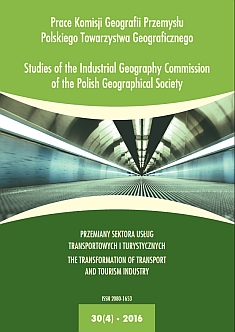Consumers’ Behaviour of Poles Using Polish-Egyptian Travel Agencies in Sharm el Sheikh
DOI:
https://doi.org/10.24917/20801653.304.8Keywords:
Egypt, international tourism, Sharm el Sheikh, travel agencies, tripAbstract
Egypt is more and more popular with Polish tourist. The extremely affordable price of the events as compared to offers of other coastal states favours the trips. One of the reasons is the fact that Egypt constitutes one of the so-called “dollar destinations”. This means that tour operators organizing events in this country settle in the US dollars. In the situation when the US dollar exchange rate is lower in relation to the euro and the Polish zloty is strong in relation to both these currencies, trips to Egypt have very attractive prices. The main purpose of tourists coming to Egypt is recreational tourism (beautiful beaches), diving courses, snorkelling, windsurfing, sailing, yachting, fishing, golf and cultural tourism. Intensity of the interest and financial capabilities of the potential clients have resulted in the formation of local travel agencies that deal with satisfying new needs. This happened through creating offers regarding tourism and recreation. The annual significant number of the Polish tourists coming to Egypt who want to get to know and visit it has contributed to the fact that Polish-Egyptian travel agencies that offer local optional trips to tourists are opened in the Egyptian resorts. The paper discusses the activity of the largest Polish-Egyptian travel agencies in Sharm el Sheikh, such as E Sharm.Pl, Sunny Sharm, PolSharm, Sunny Shore or Egypt Tours. The author presents the results of the research that was conducted in August 2015 in Sharm el Sheikh among the Polish tourists who had used the services provided by the local travel agencies. The data determining which form of tourism and recreation the respondents in Egypt prefer, what made them use the services of the specific travel agency, how they got to know about its existence, how many optional trips they participated in, what they were driven by while choosing the local travel agency and how much money they spent in the Polish-Egyptian travel agencies providing services in Sharm el Sheikh. The analysis of the optional trips that are most frequently chosen by the Polish students and assessment of their organization is also provideDownloads
References
Abdou, D.S., Zaazou, Z. (2013). The Egyptian Revolution and post Socio-economic impact. Topics in Middle Eastern and African Economies, 15, 92–115.
Al Hamarneh, A. (2006). Economic growth, social development and international tourism – cases from the Arab World. Imagine there is no countries – Inequality and Growth in Age of Tourism, 5th Interanational Symposium on Tourism and Sustainability, conference handbook.
Campas (2015, 12 grudnia). Pozyskano z www.capmas.gov.eg
Cook, S., Perry, T., Ward, G. (2008). USA część zachodnia, praktyczny przewodnik. Bielsko-Biała: Wydawnictwo Pascal.
Dziedzic, T., Łopaciński, K., Saja, A., Szegidewicz, J. (2009). Wpływ światowego kryzysu gospodarczego na stan i perspektywy rozwoju sektora turystyki w Polsce. Warszawa: Departament Turystyki Ministerstwa Sportu i Turystyki.
Fiedler, R. (2014). Arabska Wiosna – szanse i wyzwania dla polityki USA wobec Bliskiego Wschodu. Przegląd Politologiczny, 1, 33–49.
Flick, U. (2012). Projektowanie badania jakościowego. Warszawa: PWN.
Gotowt-Jeziorska, A., Łopaciński, K. (red.) (2011). Turystyka w Polsce w okresie kryzysu. Warszawa: Polskie Stowarzyszenie Turystyki.
Gray, M. (1998). Economic reform, privatization and tourism in Egypt. Middle Eastern Studies, 34(2), 91–112.
Hanna, M.S. (2013). The Tourism Crisis in post January 25th Egypt. Kair: The American University in Cairo.
Jemielniak, D. (2012). Czym są badania jakościowe? W: D. Jemielniak (red.). Badania jakościowe: Podejścia i teorie. Warszawa: PWN.
Kurek, S., Wacławik, P. (2013). Zróżnicowanie zagranicznej turystyki przyjazdowej w Unii Europejskiej w czasie kryzysu gospodarczego. Prace Komisji Geografii Przemysłu Polskiego Towarzystwa Geograficznego, 24, 9–24.
Marciniak, M., Dłużewska, A. (2015). Wpływ Wiosny Arabskiej na turystykę w Egipcie. Turystyka Kulturowa, 9.
Mazurek-Łopacińska, K. (2005). Badania marketingowe. Warszawa: PWN.
Mika, M., Faracik, R. (2008). Międzynarodowy ruch turystyczny. W: W. Kurek (red.). Turystyka. Warszawa: PWN, 66–120.
Sattin, A., Franquet, S. (2003). Przewodnik po Egipcie. Bielsko-Biała: Wydawnictwo Pascal.
Silverman, D. (2008). Prowadzenie badań jakościowych. Warszawa: PWN.
Tohamy, S., Swinscoe, A. (2000). The economic impact of tourism in Egypt. The Egyptian Center for Economic Studies, 40.
UNWTO (2013). Tourism Highlights.
Zdanowski, J. (2013). Znaczenie Arabskiej Wiosny. Krakowskie Studia Bliskowschodnie, 3, 13–32.
Zdon-Korzeniowska, M., Rachwał, T. (2011). Turystyka w warunkach światowego kryzysu. Prace Komisji Geografii Przemysłu Polskiego Towarzystwa Geograficznego, 18, 116–128.
Downloads
Published
How to Cite
Issue
Section
License
Articles are published under the terms of the Creative Commons License (CC BY-ND 4.0; Attribution– NoDerivs).

